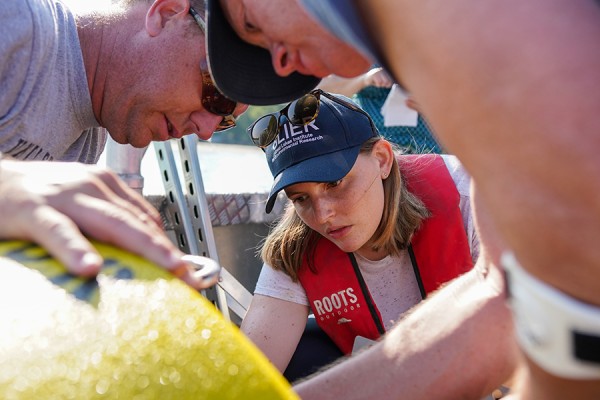Seed Funding
Description
CIGLR provides seed funding for Regional Consortium members to initiate research on emerging issues and respond to emergencies in the Great Lakes. We broadened the former rapid fund program beyond its focus on emergency response to encompass work on emerging issues and research directions, to help provide the foundation for new research initiatives. Any principal investigator from the Regional Consortium may request seed funding.
Seed funding – request for proposals
There is no deadline for this opportunity.

Researchers Trevor Pitcher (back), Katelynn Johnson (middle), and Aaron Fisk (front) prepare high-tech buoys to deploy in the Detroit River channel between LaSalle and Fighting Island. Photo Credit: University of Windsor.
Current Seed Funding
Click here to learn more
Project Title: 2024 Rapid Funding Request: Degradation of Microcystin in Harmful Algal Bloom Aerosols during Atmospheric Transport
Key Project Personnel: Kaisen Lin (Michigan State University)
About: Climate change has been causing an increased frequency of harmful algal blooms (HABs). These blooms result in toxin-laden aerosols that pose significant public health issues. Numerous studies, conducted both in laboratory settings and in the field, have demonstrated the aerosolization of toxins from these algal blooms in freshwater environments. Epidemiological studies suggest that respiratory irritation is notably more prevalent among individuals who frequently visit recreational lakes. Subsequent toxicological research, utilizing animal models, has aimed to investigate the health impacts associated with inhalation of these airborne toxins. Despite these efforts, there remains a substantial gap in our understanding of the specific health effects on humans. One particular area of uncertainty is whether toxins in aerosols undergo degradation during atmospheric transport, prior to reaching human recipients. Our hypothesis posits that these airborne toxins may degrade similarly to other environmental pollutants, leading to reduced concentrations and the formation of degradation byproducts. The main goal of this proposed research is to deepen our understanding of the behavior and fate of airborne toxins released from HABs during their atmospheric transport. Findings from this study are expected to improve estimations of human exposure levels to HAB toxins, providing essential data for further biomedical research into associated health outcomes.
To address this research question, experiments will be conducted in a controlled environment within Dr. Kaisen Lin’s laboratory using a rotating drum apparatus. Standard solutions of microcystin-LR and RR will be aerosolized using a Collison nebulizer and introduced into a rotating drum, where the aerosols will be suspended in the air for extended periods. This setup is designed to subject the aerosols to various environmental conditions, such as various levels of relative humidity and UV light intensities, to simulate and study their degradation during the atmospheric transport process. The aged aerosols will then be collected on glass fiber filters and extracted prior to analysis by LC/MS/MS. This analysis will determine the concentrations of microcystin-LR and RR in the aged samples, thereby facilitating an investigation into their air degradation kinetics. Concurrently, degradation products will be screened to identify any potential toxic byproducts that could pose human health risks. Additionally, changes in the size of the toxin-laden aerosols will be measured using a Scanning Mobility Particle Sizer. This data will inform the Multiple-Path Particle Dosimetry model, which will be used to simulate the deposition of airborne toxins in the human respiratory tract. The outcomes of this simulation will shed light on the dose and deposition locations of toxin-laden aerosols, providing valuable guidance for subsequent toxicological studies.
The proposed work aims to gather essential preliminary data to inform subsequent toxicology studies. At the conclusion of this project, my intention is to seek external funding to extend this research and comprehensively address the research question. The future work will encompass: (1) partnering with biomedical researchers to examine the toxic effects of the microcystin with precisely selected lung cell models, (2) studying the degradation kinetics of various toxins in real freshwater samples collected during HAB episodes, and (3) investigating the inactivation mechanisms of airborne algae. Through these synergistic and collaborative endeavors, the study aims to provide thorough insights into the exposure to toxins generated by HABs, thus enhancing our capacity to evaluate and counteract the associated public health impacts. Potential sources for future funding include NSF’s CBET program and NIEHS.
